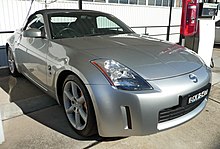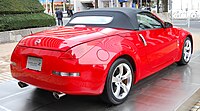Nissan 350Z
| Nissan | |
|---|---|
|
Nissan 350Z Coupe (2002-2005)
|
|
| 350Z (Z33) | |
| Production period: | 2002-2009 |
| Class : | Sports car |
| Body versions : | Station wagon , roadster |
| Engines: |
Petrol engines : 3.5 liters (206–230 kW) |
| Length: | 4310-4315 mm |
| Width: | 1815 mm |
| Height: | 1315-1325 mm |
| Wheelbase : | 2650 mm |
| Empty weight : | 1600-1725 kg |
| Previous model | Nissan 300ZX |
| successor | Nissan 370Z |
The Nissan 350Z is a two-seater sports car from the Japanese automaker Nissan , which was built from mid-2002 to summer 2009. It is the fourth generation of the manufacturer's Z sports car series, which began in 1969 with the 240Z and was then continued with the 280ZX and two generations of the 300ZX until summer 2000. Only a station wagon coupé was available for the market launch , which was supplemented by a roadster version from summer 2003 . The number "350" indicates the engine displacement in centiliters .
In late autumn 2008, the successor model 370Z came onto the market as a coupé in Japan, the roadster was replaced in late summer 2009.
prehistory
In the 1990s Nissan was plagued by a severe financial crisis, which is why the group concentrated on the development and sale of volume models in order to get back into the black. The then representative of the Z series, the 300ZX, was gradually taken out of the range due to lack of demand without a successor, including in 1995 in Europe and 1996 in North America. The reason for the poor sales was the excessively high market prices for the prestige object of the Nissan concern, which was overloaded with technical gadgets.
Nevertheless, they did not want to allow the traditional Z to be forgotten, especially in the important US market. Therefore, a limited number of original 240Zs were purchased there in 1998, professionally restored and then sold at authorized dealers for around US $ 24,000 each.
Z concept (1999)

At the end of the 1990s, a design team from Nissan North America developed a first concept vehicle for a successor to the 300ZX on its own and initially without official support from Nissan . An original 240Z from an employee served as a model for the designers, and as a result, this first version with a long bonnet, round front headlights and short overhangs leaned heavily on the original Z from 1969. However, the aim was not to copy the old design, but rather to interpret the lines of the classic body in a modern way. The concept vehicle was equipped with a performance-enhanced 2.4-liter in-line four-cylinder from the Nissan engine range and a five-speed manual transmission, making it fully functional.
The two-seat study was completed in just 12 weeks and finally presented at the 1999 Detroit Auto Show. Although there was a certain disappointment that, contrary to the tradition of the Z series, no six-cylinder engine was used and the design was very retro-heavy, the orange-painted concept vehicle attracted a lot of attention and brought the ailing Nissan group into the news with positive headlines.
Z concept (2001)
After the successful presentation of the Z concept vehicle in 1999, the top management decided to develop a new generation of the Z series despite the ongoing merger negotiations with Renault. The design of the original Z-Concept, which was perceived as too retro, was discarded. Under chief designer Mamoru Aoki, Nissan design studios in Japan, Germany and the United States worked on the final design. The result was a modern and completely new-looking sports car, which nevertheless reflected the history of the Z series and expressed the then new Nissan design language.
The second-generation Z concept, painted again in orange, premiered at the Detroit Auto Show in 2001 and was once again able to delight the public. With its V6 engine with a displacement of 3.5 liters and an output of 192 kW (260 hp) as well as the classy coupé shape, the concept vehicle was a worthy outlook on the announced production version of the next Z evolutionary stage.
Model history
Coupé (2002-2008)
After a two-year break, the Z sports car series finally returned with the 350Z, which began sales in Japan in July 2002. It was launched on the German market over a year later in October 2003 at a base price of EUR 33,850.
As is usual in the Z series, the 350Z should also come up with classic sports car proportions; the final design of the body was very similar to that of the study presented in 2001. The beefy two-seater has a classic sports car design with a front engine installed lengthways - the center of gravity, however, is behind the front axle - and rear-wheel drive. The power transmission takes place as standard via a manually shifted gearbox with six gears, in some markets an automatic with five levels was also available. To save weight, the transmission is through a one-piece propshaft of carbon fiber reinforced plastic ( composite ) with the Visco - locking differential connected to the rear axle. The 350Z serves as a motor six-cylinder - petrol engine in V-type aluminum with four valves per cylinder and four overhead camshaft , the internal motor code VQ35DE wears. From 3.5 liters capacity which draws suction motor 206 kW (280 hp) at 6200 min -1 and a maximum torque of 363 Nm at 4800 min -1 . This power is sufficient for an acceleration of 0-100 km / h in 5.9 seconds and a top speed of 250 km / h, at which the 350Z is electronically limited. The average consumption is 11.4 liters of super plus petrol per 100 kilometers.
Difficulties were encountered in the Combi Coupé hatchback with tailgate, as this construction method has drawbacks for the body stiffness. This problem was countered with subframes at the front and rear, strut braces , reinforced welds on the floor pan and other measures. In order to achieve the sporty driving behavior possible, attention was paid to a low center of gravity and a balanced weight balance. This could be ensured by using lightweight materials such as aluminum , from the bonnet and most of the chassis components , or by dispensing with complex and heavy technologies such as turbocharging , variable intake systems or all-wheel steering . The result was a weight distribution of 53% on the front and 47% on the rear axle, to which the position of the engine with its center of gravity behind the front axle also contributed. Another advantage of doing without complicated and therefore expensive technology was the lower costs in development and production. These savings could be passed on to the end customer, which was reflected in a relatively low sales price and thus also a good price-performance ratio .
The interior is also tailored to suit the driver. The driver's seat is a sports seat with high sides for good lateral support and an additional elevation in the front area of the seat surface to guide the thighs. In addition, the backrest is cut narrower below the shoulder zone to ensure optimal arm freedom for switching and steering. The passenger seat, on the other hand, offers more comfort with a wide backrest and softer upholstery and also dispenses with the central elevation of the seat cushion. Behind the three-spoke steering wheel is the instrument cluster , which is divided into three large round instruments for the speedometer , rev counter and the combined coolant and fuel gauge . The tachometer is larger than the displays next to it and positioned in the middle, making it easy to read. The instrument cluster is firmly attached to the steering column and moves with the height adjustment of the steering wheel. In the dashboard above the center console there are three additional instruments aligned with the driver's seat, which contain displays for oil pressure , on-board voltage and the on-board computer . Behind the front passenger seat there is an additional, larger shelf that complements the 235 liter trunk, which is severely restricted by the rear strut bar.
For the German market, the 350Z was equipped with a few extras as standard because of the higher average speeds there. An electronic stability program and a larger water cooler are standard in all European versions. In addition, the aerodynamics have been modified. Air ducts on the underbody ensure that the differential on the rear axle , which is equipped with additional cooling fins , has a good flow. An “Aero Kit” with a spoiler lip on the tailgate, modified front apron and diffuser on the underbody made it possible to reduce the drag coefficient from 0.30 to 0.29, while increasing the contact pressure at the same time. Also not all international versions was Brembo - Sport brake system given, the brake calipers made of aluminum and gold are powder coated. These were installed in series in the German variants. The brake system has four pistons on the front and two pistons on the rear axle. The internally ventilated brake discs have a diameter of 324 mm on the front axle and 322 mm on the rear axle.
The 350Z Coupé was replaced by the 370Z in December 2008 .
Roadster (2003-2009)
A roadster of the Nissan 350Z was produced from summer 2003 . It was first launched in North America in July and in Japan in October. From March 2005 the roadster was also offered in Germany. The introductory price on the German market was 36,500 euros.
The engine, transmission, chassis and interior are unchanged from the coupé. The body is based on that of the coupé, however, because the roadster does not have a roof, additional stiffeners were necessary. A V-shaped beam was attached below the seats to connect the side skirts , which is supported by an A-shaped frame in the bow and an M-shaped strut in the transmission tunnel. In the area of the sills, A-pillars and the trunk floor, additional reinforcements have been added. Behind the seats there is a steel tube to which the roll bars are attached, which together with the high-strength windshield frame provide protection in the event of a rollover. The partition walls between the passenger compartment, convertible top tub and trunk also have a stiffening effect.
The folding fabric roof of the roadster can be retracted and extended electrically in around 20 seconds, only when the vehicle is stationary with the brake pedal depressed and with no gear engaged. To prevent the top from inflating when driving fast, it is locked at three points when it is closed. By manually operating a central locking lever, it locks into place on the left, right and in the center of the window frame. When folded, it is stowed between the cockpit and the 130 liter trunk in the convertible top tray, which is closed with a plastic cover painted in the vehicle color. The soft top also has an electrically heated pane. When the top is open, humps behind the seats, a glass wind deflector with an embossed Z logo and an adapted plastic trunk lid ensure low noise and air turbulence. The drag coefficient is 0.34.
The seats in the Roadster are always equipped with electrical adjustment so that the backrest of the passenger seat can automatically tilt slightly forwards while the convertible top is operated. This prevents the convertible top from coming into contact with the front passenger's head. However, this function can also be deactivated. When empty, the Roadster is around 110 kilograms heavier than the Coupé, due to the reinforcements, the soft top construction and the electrical system of the seats. The open version of the 350Z takes 6.3 seconds to accelerate to 100 km / h.
With the market launch of the roadster, all Z models were slightly freshened up in the interior with new "soft" paints, a 12-volt socket on the dashboard, modified belt guides and soft padding on the center console for knees and elbows and with a tandem brake booster for improved Braking effect equipped.
The Nissan 370Z there is also a roadster, which succeeded the 350Z Roadster. Sales started in late summer 2009.
Facelift
2005
In September 2005 the 350Z was slightly modified visually and technically. LED taillights and bi-xenon headlights are now used, as are polished 18-inch light-alloy wheels in five-star design as standard wheels. At the front there is a redesigned bumper, a new radiator grille with two instead of the previous three cross braces and modified side reflectors. The interior has been visually upgraded with more aluminum optics, and storage compartments have been made more spacious or additional ones have been added. For the dashboard and the center console, softer materials were used and the switches for the seat heating and hazard warning lights were positioned elsewhere. New fabric covers for the seats are available for the basic equipment. The door panels of the variant with Premium Pack were provided with leather inserts, and for this upscale version was now an optional "Birdview" - DVD - navigation system with seven-inch large color monitor, the same took place below the dashboard instruments available. In addition, there were two new metallic exterior colors in black and silver, and the steering support of the power steering is now a function of speed.
The motor continues to be a VQ35DE whose power but at 221 kW (301 hp) at a slightly higher speed of 6400 min -1 was increased. To do this, the intake tract was adapted, the weight of the connecting rods and pistons optimized and new camshafts and a variable exhaust valve control installed. The changes to the engine maximum torque dropped from 363 to 353 Nm at 4800 continues min -1 . However, the torque curve is now flatter and is no longer subject to sharp drops after reaching the maximum, as was the case before the increase in performance. Acceleration to 100 km / h improved to 5.8 seconds for the Coupé, but remained the same for the Roadster.
2007
In January 2007 was the 350Z again facelift given. Instead of the previous two beads, the bonnet is now arched, making its shape reminiscent of the Nissan 240Z . This modification to the bonnet was necessary because of the increased space requirement of a different intake tract, which was necessary in the course of the introduction of the new VQ35HR engine. The new engine is a further development of the VQ35DE , with around 80 percent of the components being revised and the compression ratio increased from 10.3: 1 to 10.6: 1. The engine has an output of 230 kW (313 hp) at 6800 min −1 , the maximum torque is 358 Nm at 4800 min −1 and the speed limit is 7500 min −1 . The top speed remains unchanged at 250 km / h and the Coupé accelerates from 0 to 100 km / h in 5.7 seconds. This engine is also used in the Infiniti G35 model .
Furthermore, the seats are now equipped with active headrests , and the selection of leather seats has been expanded to include gray "Frost" covers in addition to the seats in "Charcoal Black" and "Alezan Orange". Three new metallic finishes were also available: A53 Temper Orange (replaced A17 Sunset Orange), BW5 Night Blue (replaced B17 Monterey Blue) and K51 Precision Gray (replaced WV2 Gun Gray).
Special models
2005 - 35th Anniversary Edition
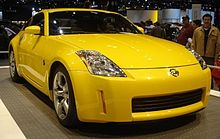
On the occasion of the 35th anniversary of the Z sports car series, Nissan launched a "limited" version of the 350Z, which was only available in Japan, Europe and the USA. Only 100 of the limited edition of 700 in Europe were intended for Germany.
The most important change in the 35th Anniversary Edition concerns the VQ35DE engine, which was installed in a more powerful version. Its output has been increased to 221 kW (301 hp), which reduces the sprint time from 0-100 km / h to 5.8 seconds. The increase in performance was made possible by various measures such as a modified intake system, variable exhaust valve timing, reduced internal friction and different camshafts, which led to better response behavior and a higher maximum speed. After the first facelift in September 2005, this revised engine was installed in all production versions of the 350Z.
Only two liveries were available for the limited 350Z. 20 of the models intended for Germany were painted in a bright metallic yellow, the remaining units were kept in a subtle black. In addition, exclusive 18-inch alloy wheels were installed at the time, which have been the standard wheels for all models since the facelift in autumn 2005. The 350Z 35th Anniversary Edition could be ordered from May 2005 at prices of 38,250 euros for the black and 38,840 euros for the yellow version. For each special model delivered, Nissan also had a Playstation 2 game console and the racing game Gran Turismo 4 - the reason: the 350Z 35th Anniversary Edition is mobile in this game.
2007 - Racing Edition
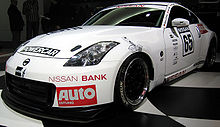
To commemorate the 24-hour race at the Nürburgring in 2007, there was a special edition of the Nissan 350Z, limited to 50 pieces, which was only available in Germany. This model was inspired by the 350Z GT4 racing car that took part in the aforementioned endurance race in the Eifel.
The Racing Edition is based on a 350Z with Premium Package and is painted in the exclusive color Pikes Peak Metallic White . Multi-part 19-inch alloy wheels with a black painted star and a highly polished rim base are mounted. The suspension was filtered through a series höhenjustierbares Gewindefahrwerk of Bilstein replaced, the a lowering allowed from 25 to 45 millimeters, and in addition in rebound and compression is ten times adjustable. The special model was rounded off by a rear silencer from the tuner Cobra. In addition, the standard 18-inch rims including winter tires and a set of sponsor stickers in racing style were included. No changes were made to the engine, the 230 kW (313 hp) VQ35HR engine was installed, which was used in all versions of the 350Z from the 2007 facelift .
In the interior of the Racing Edition there is a numbered badge with the signatures of the four 350Z GT4 drivers Kurt Thiim , Holger Eckhardt , Nicole Lüttecke and Tim Schrick . The special model could be ordered from July 2007 at a price of 48,590 euros.
Nismo 350Z (2007-2008)
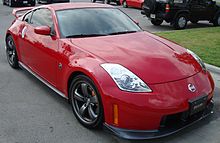
The Nismo 350Z Coupe was introduced at the New York International Auto Show on April 4, 2007. It was available in Japan and the USA.
The Nismo version has the same VQ35HR engine as the regular 350Z, which delivers 310 hp in US specification, and was only available with a 6-speed manual transmission. The aggressive spoiler all around, which has been optimized in the wind tunnel and provides downforce at the front and rear, immediately catches the eye. The aerodynamic package consists of an adapted front apron with spoiler sword, side skirts and a wide rear apron with integrated diffuser as well as an additional rear wing on the trunk lid. According to Nissan, the standard US model of the 350Z generates around 8 kg of lift on the rear axle at 75 mph (120 km / h), while the Nismo variant generates around 15 kg of downforce at this speed. Further changes were made to the exhaust system, which was specially designed by Nismo.
In addition, the body was additionally welded to the A and B pillars and a reinforced strut bar was attached to the rear in order to improve the rigidity of the chassis, which is already extremely torsion-free. The chassis has also been upgraded with stiffer springs, tighter dampers and a larger stabilizer on the rear axle. These changes made body dampers necessary to eliminate disruptive vibrations. These are attached between the two side members, one damper sits in the front near the water cooler and a second in the rear section below the trunk. The built-in Brembo brake system corresponds to that of the German model.
The Nismo 350Z was delivered with forged light alloy rims in the dimensions 9x18 inches at the front and 10x19 inches at the rear. The tires in size 245/40 R18 at the front and 265/35 R19 at the rear come from Bridgestone , which supplied sports tires of the Potenza RE050A type for the US model and Potenza RE01R for the vehicles destined for Japan. The 350Z from Nismo was factory-fitted with powerful bi-xenon headlights and LED brake lights. Electronic traction control and a differential lock were also part of the standard equipment of the sports car, which is available in four different exterior colors: white, red, black and silver. An interior with black and red seat cushions and red stitching as well as a numbered aluminum badge with the Nismo logo in the center console underline the exclusivity of the special model.
The Nismo 350Z went on sale at Nissan dealers in the United States in July 2007. It was produced from 2007 to 2008. The car had a manufacturer suggested retail price of $ 38,070 for the 2007 model year.
Technical specifications
| Nissan Z33 | 350Z | ||
| Construction period: | 2002-2005 | 2005-2007 | 2007-2009 |
| Engine type: | Six cylinders - gasoline engine in V-type | ||
| Displacement: | 3498 cc | ||
| Engine code: | VQ35DE | VQ35HR | |
| Bore × stroke: | 95.5 x 81.4 mm | ||
| Max. Performance in min -1 : | 206 kW (280 PS) at 6200 |
221 kW (300 hp) at 6400 |
230 kW (313 hp) at 6800 |
| Max. Torque at min -1 : | 363 Nm at 4800 | 353 Nm at 4800 | 358 Nm at 4800 |
| Compression: | 10.3: 1 | 10.6: 1 | |
| Mixture preparation: | Manifold injection | ||
| Valve control: | DOHC , timing chain, 4 valves per cylinder | ||
| Cooling: | Water cooling | ||
| Gearbox, as standard: | 6-speed manual transmission | ||
|
Gearbox, optional: (not in Germany) |
5-speed automatic transmission | ||
| Drive type: | Rear wheel drive | ||
| Front suspension: | Double wishbone axle mounted on subframe , strut , stabilizer | ||
| Rear suspension: | Multi-link axle mounted on subframe, shock absorber and coil spring separated, stabilizer | ||
| Brakes: | ventilated disc brakes all around, brake booster , ABS , EBD , BAS | ||
| Steering: | power-assisted rack and pinion steering | Servo-assisted rack and pinion steering, speed-dependent from 9/2005 |
Speed-dependent, servo-assisted rack and pinion steering |
| Dimensions (L × W × H): | 4310 [4315] × 1815 × 1315 [1325] mm | ||
| Wheelbase: | 2650 mm | ||
| Track width front / rear: | 1535 / 1540-1545 mm | ||
| Weight: | 1600–1625 kg [?] |
? [1,705–1,725 kg] |
1605–1630 kg [1700–1720 kg] |
| Trunk volume: | 235 [130] liters | ||
| Top speed: | 250 km / h, electronically limited | ||
| 0-100 km / h: | 5.9 s [6.3 s] |
5.8 s [6.3 s] |
5.7 s [6.1 s] |
| Fuel type: | Super plus (98 RON) | ||
| Tank capacity: | 80 liters | ||
| Consumption, combined (liters / 100 kilometers): | 11.4 [11.7] |
? [12.0] |
11.7 [12.0] |
| CO 2 emissions, combined: | 273 g / km [?] |
? [?] |
280 g / km [288 g / km] |
| Values in square brackets apply to the roadster. Measured values for models with automatic transmission not taken into account. | |||
Motorsport

The 350Z was and is used both as a GT racing car and as a touring car in various racing series, for example in the Super GT , the British GT Championship or in the 24-hour race at the Nürburgring .
JGTC / Super GT
The Nissan 350Z was used as a racing version from 2004 in the GT500 class of the popular Japanese GT racing series. It replaced the racing cars of the Nissan Skyline GT-R , which until then had been available to the factory and customer teams. Two 350Z GT500s started this season for the Nismo works team, and one more each for the private racing teams Hasemi Motorsport and Team Impul. The heavily modified racer is powered by a twin -turbo- charged 3.0-liter VQ30DETT engine , which drives the 1080 kg vehicle with a maximum output of 342 kW (465 hp). The Nismo works team immediately won the driver and team championship in the GT500 class. In the following season the team championship could be won again. In 2007 the 350Z drove for the last time with factory support in the GT500 class, it was replaced by the Nissan GT-R in the following season .
The 350Z was also used in the GT300 class, but only by private racing teams. In 2003 they won the drivers 'title and in 2008 and 2010 the drivers' and team titles.
Production facilities
The 350Z was only manufactured in Japan, initially at the Nissan Oppama plant in the city of Yokosuka , which is located in Kanagawa Prefecture . In January 2004, production was relocated to the Tochigi plant in Kaminokawa City ( Tochigi Prefecture ).
annotation
The factory code for the 350Z is Z33 . In Japan, the model name of different Z33 of the other markets, it is there Nissan Fairlady Z called. This designation was the first series Datsun 240Z from Datsun Fairlady adopted and has since traditionally the Z series for the Japanese market used in previously all generations.
Web links
- Z - The sign of a legend autowallpaper.de
Individual evidence
- ↑ Driving report: Nissan 350Z Roadster alle-autos-in.de from March 15, 2005, accessed on February 7, 2012
- ↑ a b Follow-Up Test: 2007 Nissan Nismo 350Z insideline.com from July 24, 2007, accessed on September 12, 2012
- ↑ Price list and technical data Nissan 350Z Coupé 2005 (PDF file; 206 kB)
- ↑ Price list and technical data Nissan 350Z Coupé and Roadster 2007 (PDF file; 277 kB)
swell
- Joachim Kuch: Nissan since 1933. Motorbuch Verlag, Stuttgart 2005, ISBN 3-613-02491-8
- Concept: The Nissan Z
- Nissan 240Z Concept (1999) Central Florida Z Club, accessed December 10, 2011
- Nissan Z Concept: Golden Comeback spiegel.de from January 11, 2001, accessed on December 22, 2011
- Nissan 350Z autosieger.de test report from July 23, 2003, accessed on February 3, 2012
- Nissan 350Z Roadster autosieger.de test report from March 4, 2005, accessed on February 3, 2012
- Nissan Releases All-New Fairlady Z nissan-global.com on July 30, 2002, accessed February 3, 2012
- Nissan Releases New Fairlady Z Roadster nissan-global.com on October 1, 2003, accessed February 3, 2012
- Special model Nissan 350Z 35th Anniversary Edition autosieger.de from March 18, 2005, accessed on February 3, 2012
- Nissan 350Z in limited racing edition autosieger.de from July 10, 2007, accessed on February 3, 2012
- Model update for the Nissan Z series autosieger.de from December 5, 2005, accessed on February 4, 2012
- Nissan 350Z at the Geneva Motor Show 2007 autosieger.de from February 13, 2007, accessed on February 4, 2012
- Nissan 350Z racing version revealed autosieger.de on February 13, 2004, accessed on February 4, 2012
- 2007 Nissan NISMO 350Z caranddriver.com from March 2007, accessed September 12, 2012
- 2007 Nissan Nismo Z (Road Test) caranddriver.com from December 2007, accessed September 12, 2012


